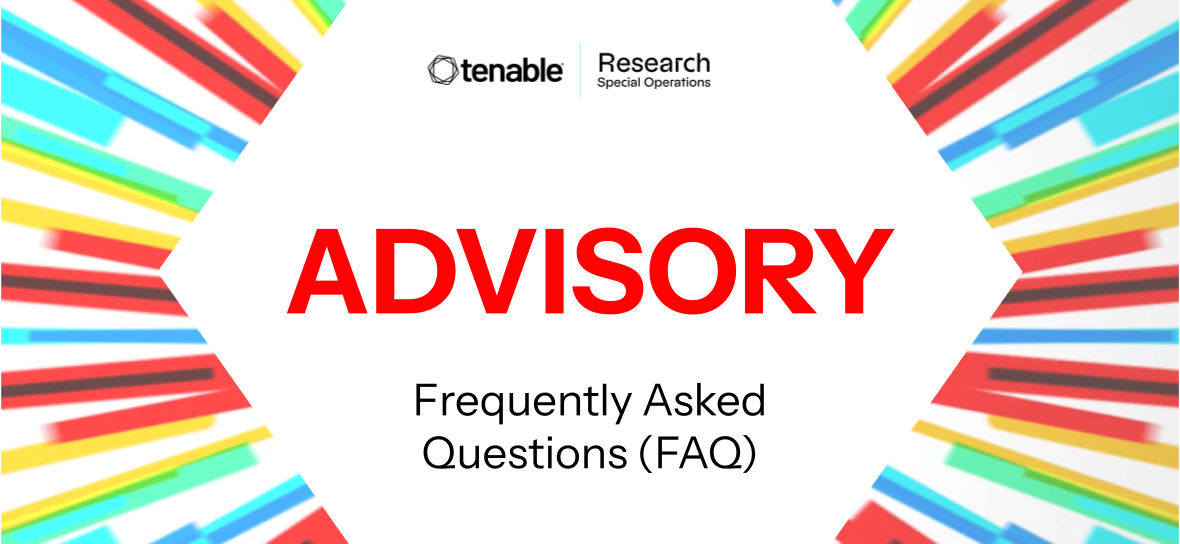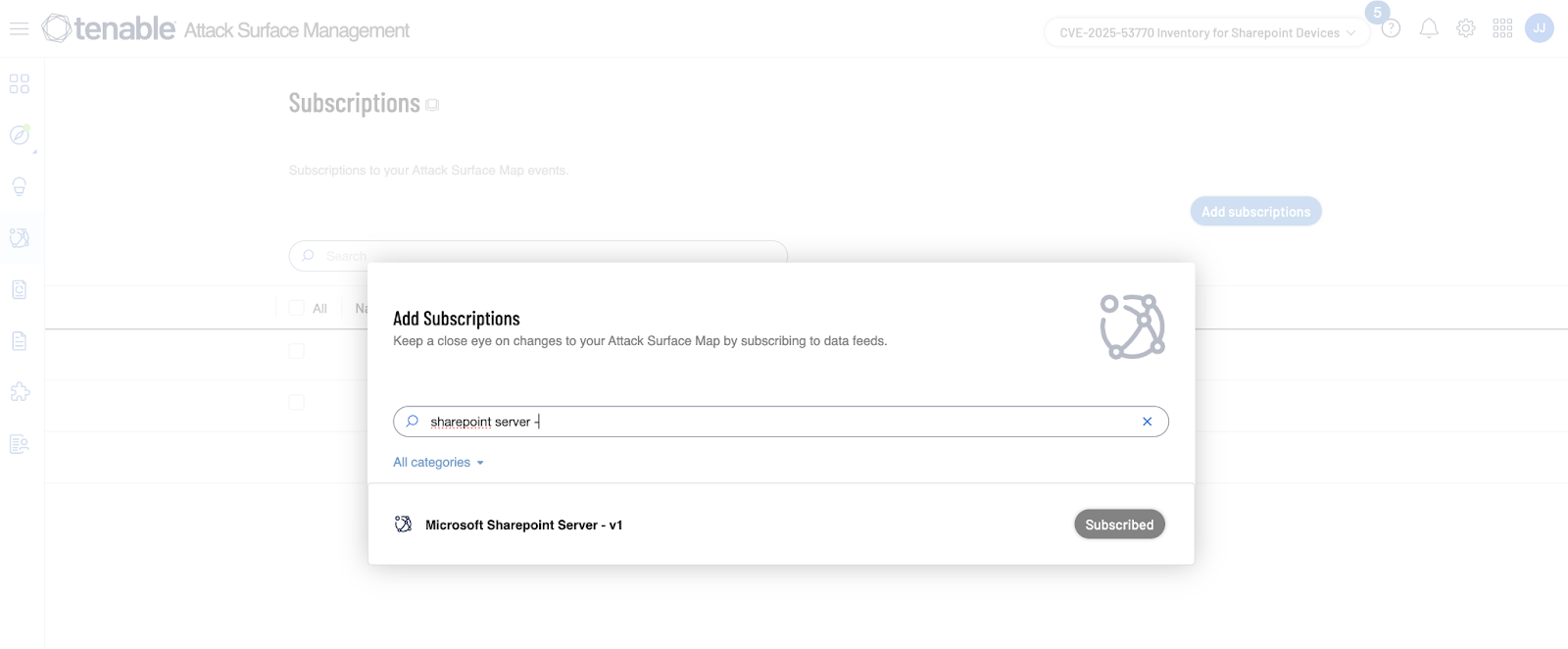CVE-2025-53770: Frequently Asked Questions About Zero-Day SharePoint Vulnerability Exploitation

Successful exploitation of CVE-2025-53770 could expose MachineKey configuration details from a vulnerable SharePoint Server, ultimately enabling unauthenticated remote code execution.
Update July 25: The blog has been updated to include a report that Storm-2603 is exploiting the ToolShell vulnerabilities to deploy the Warlock ransomware.
Background
Tenable’s Research Special Operations (RSO) team has compiled this blog to answer Frequently Asked Questions (FAQ) regarding a zero-day SharePoint Server vulnerability that has been exploited in the wild.
FAQ
When was the SharePoint exploitation first disclosed?
On July 19, reports emerged that Microsoft SharePoint Servers around the world were under active exploitation. Researchers at Eye Security published a blog post detailing their identification of an “active, large-scale exploitation” that was initially linked to a pair of vulnerabilities in SharePoint dubbed ToolShell.
What are the vulnerabilities associated with ToolShell?
ToolShell was the name given to a pair of vulnerabilities used as part of an exploit chain in SharePoint Server disclosed at Pwn2Own Berlin by security researcher Dinh Ho Anh Khoa of Viettel Cyber Security.
| CVE | Description | CVSSv3 |
|---|---|---|
| CVE-2025-49706 | Microsoft SharePoint Server Spoofing Vulnerability | 6.3 |
| CVE-2025-49704 | Microsoft SharePoint Remote Code Execution Vulnerability | 8.8 |
The SharePoint patch for Pwn2Own Berlin has been released - patch ASAP
The exploit need only one request💣
I’d name this bug ToolShell - ZDI did say the endpoint is ToolPane after all😅https://t.co/I5Lwzj0aOx#CVE_2025_49706 #CVE_2025_49704 #SharePoint #Pwn2Own pic.twitter.com/HqGvV61Plw— Khoa Dinh (@_l0gg) July 10, 2025
Was ToolShell actually used in these attacks?
Yes, Microsoft confirmed on July 22 that they observed exploit attempts using the ToolShell vulnerabilities. However, Microsoft also published a blog post on July 19 that included a new CVE identifier for a zero-day vulnerability used in the attacks detailed by Eye Security.
| CVE | Description | CVSSv3 |
|---|---|---|
| CVE-2025-53770 | Microsoft SharePoint Server Remote Code Execution Vulnerability | 9.8 |
According to Microsoft, CVE-2025-53770 is a “variant” of one of the ToolShell vulnerabilities, CVE-2025-49706.
Following the publication of our FAQ blog on July 20, Microsoft updated its blog post, creating an additional CVE:
| CVE | Description | CVSSv3 |
|---|---|---|
| CVE-2025-53771 | Microsoft SharePoint Server Spoofing Vulnerability | 6.3 |
Microsoft says that both CVE-2025-53770 and CVE-2025-53771 were created to provide “more robust protections” than CVE-2025-49704 and CVE-2025-49706.
How severe is the exploitation of CVE-2025-53770?
Successful exploitation of CVE-2025-53770 could grant an attacker the ability to obtain MachineKey configuration details from a vulnerable SharePoint Server to create specially crafted requests that could enable unauthenticated remote code execution.
How widespread are the attacks exploiting CVE-2025-53770?
A post from The Shadowserver Foundation on X confirmed that at least 9,300 SharePoint servers were publicly accessible as of July 20. However, it is important to note that not all 9,300 servers are considered vulnerable.
Alert: SharePoint CVE-2025-53770 incidents! In collaboration with @eyesecurity & @watchtowrcyber we are notifying compromised parties. Read: https://t.co/j1rxtN32iq
~9300 Sharepoint IPs seen exposed daily (just population, no vulnerability assessment): https://t.co/rCFGTrhiDT pic.twitter.com/QEx2sJ3K4X— The Shadowserver Foundation (@Shadowserver) July 20, 2025
Has CVE-2025-53771 been exploited in the wild?
As of July 20, Microsoft’s advisory for CVE-2025-53771 does not include any references to exploitation. If that changes, we will update this blog.
Which threat actors are exploiting CVE-2025-49704, CVE-2025-49706, and CVE-2025-53770?
On July 22, Microsoft published a blog post confirming that as early as July 7, they observed exploit attempts of CVE-2025-49706 and CVE-2025-49704 by two Chinese state actors called Linen Typhoon and Violet Typhoon as well as a China-based actor called Storm-2603.
As part of an update to its blog post on in-the-wild exploitation, Microsoft says that Storm-2603 has been observed exploiting the ToolShell vulnerabilities to deploy the Warlock ransomware.
Is there a proof-of-concept (PoC) available for these vulnerabilities?
Yes, we are aware that proof-of-concept (PoC) exploits for CVE-2025-53770, including repositories that include exploit code, are now available. However, it is important to note that attackers create fake PoCs for trending vulnerabilities and host them on development platforms in order to steal information.
When this blog was published on July 20, there were no PoCs for CVE-2025-53770. However, we knew CVE-2025-53770 was a variant of CVE-2025-49706, one of the CVEs in the ToolShell chain. Researchers at CODE WHITE GmbH were able to reproduce the chain and disclosed this confirmation on X (formerly Twitter) on July 14.
We have reproduced "ToolShell", the unauthenticated exploit chain for CVE-2025-49706 + CVE-2025-49704 used by @_l0gg to pop SharePoint at #Pwn2Own Berlin 2025, it's really just one request! Kudos to @mwulftange pic.twitter.com/sPHVVBal3K
— CODE WHITE GmbH (@codewhitesec) July 14, 2025
Additionally, security researcher Soroush Dalili was able to work alongside Google’s Gemini to help identify the Microsoft SharePoint authentication bypass (CVE-2025-49706).
I originally had Gemini expecting a 200 OK instead of a 401, but after dropping a server-side breakpoint so it could use a timeout as the auth signal, it cracked the bypass! 🥈 AI + human teamwork for the win! 🎉
Next: finding the right parameters & deserialization in… https://t.co/uFwK8ANJvz pic.twitter.com/MM916K69um— Soroush Dalili (@irsdl) July 18, 2025
Are patches or mitigations available for CVE-2025-53770 and CVE-2025-53771?
On July 20, Microsoft released patches for Microsoft SharePoint Server Subscription Edition and Microsoft SharePoint Server 2019 that address both CVE-2025-53770 and CVE-2025-53771. On July 21, Microsoft released patches for Microsoft SharePoint Server 2016.
The ToolShell exploit chain was patched as part of Microsoft’s July 2025 Patch Tuesday.
Microsoft’s blog post provides mitigation instructions that include configuring AMSI integration in SharePoint Servers that do not have it enabled by default, as well as utilizing Defender Antivirus on all SharePoint servers.
Are there any indicators of compromise for exploitation of CVE-2025-53770?
Yes, there are several indicators of compromise (IoCs) that have been included in the blog post published by Eye Security, including several known IP addresses and user agent strings.
One key indicator of compromise is the creation of a file, spinstall0.aspx, on vulnerable SharePoint Servers. This file is being used to obtain the MachineKey configuration details. Microsoft also provided additional file names including spinstall.aspx, spinstall1.aspx, and spinstall2.aspx as well as other indicators.
Has Tenable classified these vulnerabilities under Vulnerability Watch?
Yes, our RSO team have classified all the vulnerabilities associated with these attacks as follows:
| CVE | Vulnerability Watch Classification | Date Added |
|---|---|---|
| CVE-2025-53770 | Vulnerability of Concern | July 20 |
| CVE-2025-53771 | Vulnerability Being Monitored | July 21 |
| CVE-2025-49704 | Vulnerability of Concern | July 22 |
| CVE-2025-49706 | Vulnerability of Concern | July 22 |
Because CVE-2025-53771 has not been confirmed as exploited in the wild and is considered "Exploitation Less Likely," we have flagged it as a Vulnerability Being Monitored.
For more information about our Vulnerability Watch classifications, please visit our blog, Reducing Remediation Time Remains a Challenge: How Tenable Vulnerability Watch Can Help.
Has Tenable released any product coverage for these vulnerabilities?
When this blog was published on July 20, there were no patches available for CVE-2025-53770. However, Microsoft has since released patches for SharePoint Server Subscription Edition, SharePoint Server 2019 and SharePoint Server 2016 that address CVE-2025-53770 and CVE-2025-53771. A list of Tenable plugins for these vulnerabilities can be found on the individual CVE pages as they’re released:
The ToolShell vulnerabilities (CVE-2025-49704, CVE-2025-49706) were patched as part of Microsoft’s July Patch Tuesday release. A list of Tenable plugins for these vulnerabilities can be found on the individual CVE pages:
This link will display all available plugins for these vulnerabilities, including upcoming plugins in our Plugins Pipeline.
Additionally, Tenable Attack Surface Management customers can identify external-facing assets by leveraging the built-in subscription labeled Microsoft Sharepoint Server - v1.

Get more information
- Microsoft: Customer guidance for SharePoint vulnerability CVE-2025-53770
- Eye Security Blog: ToolShell Mass Exploitation (CVE-2025-53770)
Change Log
Update July 25: The blog has been updated to include a report that Storm-2603 is exploiting the ToolShell vulnerabilities to deploy the Warlock ransomware.
Update July 22: The blog has been updated to include confirmation of exploitation of the original ToolShell vulnerabilities by Chinese threat actors as well as clarification on Tenable's Vulnerability Watch classifications.
Update July 21: The blog has been updated to note that Microsoft released patches for SharePoint Server 2016 and confirmation of public proof-of-concept exploits for CVE-2025-53770.
Update July 20: The blog has been updated to include an additional CVE (CVE-2025-53771) as well as preliminary coverage details for SharePoint Subscription Edition and SharePoint Server 2019.
Join Tenable's Research Special Operations (RSO) Team on the Tenable Community.
Learn more about Tenable One, the Exposure Management Platform for the modern attack surface.
- Exposure Management
- Vulnerability Management



